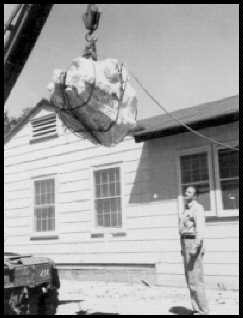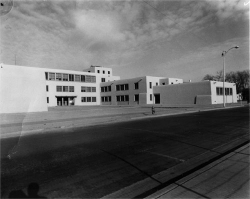Institute of Meteoritics History
In 1941, Dr. Frederick C. Leonard published a short paper in Contributions of the Society for Research on Meteorites entitled "The need for an institution for research on meteorites". He pointed out the almost complete neglect of scientific studies of meteorites and meteors, despite the fact that they are "the only tangible objects of astronomical inquiry", and suggested that the field of meteoritics was greatly in need of an institution dedicated to research in these fields. The University of New Mexico responded to this plea by founding the Institute of Meteoritics in 1944. It was the first Institute in the world to be devoted exclusively to research on meteorites.
In the late 1980s, the accomplished IOMer G. Jeffrey Taylor, who had been an Institute staff scientist and assistant director for many years, wrote up the history of the IOM to that point. Dr. Taylor has graciously agreed to lend his deathless prose to the IOM history page. That writeup can be accessed by following this link.
 The first director of the Institute was Dr. Lincoln LaPaz, who also
held a position as head of the Department of Mathematics and Astronomy
at UNM. The original objectives of the Institute were to promote
the recovery, exhibition and scientific study of meteorites, the
advancement of pure sciences such as the study of meteors, and
practical applications of such knowledge. LaPaz established an
excellent meteorite collection which is still being added to,
and which has been used extensively for research and education
throughout the history of the Institute. One of its prize specimens
is the Norton County enstatite achondrite, the largest stone of
which weighs one ton and is on display in the Institute's Meteorite
Museum. While he was director, LaPaz, seen at left with the Norton County specimen,
also helped to establish the scientific journal Meteoritics (later Meteoritics and Planetary Science), which was originally published
by the University of New Mexico Press in 1953.
The first director of the Institute was Dr. Lincoln LaPaz, who also
held a position as head of the Department of Mathematics and Astronomy
at UNM. The original objectives of the Institute were to promote
the recovery, exhibition and scientific study of meteorites, the
advancement of pure sciences such as the study of meteors, and
practical applications of such knowledge. LaPaz established an
excellent meteorite collection which is still being added to,
and which has been used extensively for research and education
throughout the history of the Institute. One of its prize specimens
is the Norton County enstatite achondrite, the largest stone of
which weighs one ton and is on display in the Institute's Meteorite
Museum. While he was director, LaPaz, seen at left with the Norton County specimen,
also helped to establish the scientific journal Meteoritics (later Meteoritics and Planetary Science), which was originally published
by the University of New Mexico Press in 1953.
 LaPaz retired from his position as director in 1966, and was
succeeded by Dr. James D. Wray. Although Wray left UNM a year
later, he made a significant impact on the Institute by recommending
that it should become affiliated with the Geology Department.
The Institute has been housed within the Geology Department (now
the Department of Earth and Planetary Sciences) ever since, and
this association is reflected in the emphasis on research into
the material (mineralogical, petrological and geochemical) properties
of meteorites since that time. Dr. Klaus Keil was appointed as director in 1967, and a new era began for the Institute. With the introduction of new analytical instrumentation, Keil established a close association with NASA, and obtained funding for research on lunar and
meteorite material. Some of the first lunar rocks to be returned by the Apollo 11 mission were studied in this laboratory. Since that time, with a new national interest in space exploration, funding for the Institute has grown steadily.
The research group expanded under Keil's directorship to a total of three PhD
(and one MS research scientist), in addition to the director. The field of research
broadened to include a wider perspective of planetary sciences, but the study
of meteorites and maintenance of the meteorite collection still remained a high
priority.
LaPaz retired from his position as director in 1966, and was
succeeded by Dr. James D. Wray. Although Wray left UNM a year
later, he made a significant impact on the Institute by recommending
that it should become affiliated with the Geology Department.
The Institute has been housed within the Geology Department (now
the Department of Earth and Planetary Sciences) ever since, and
this association is reflected in the emphasis on research into
the material (mineralogical, petrological and geochemical) properties
of meteorites since that time. Dr. Klaus Keil was appointed as director in 1967, and a new era began for the Institute. With the introduction of new analytical instrumentation, Keil established a close association with NASA, and obtained funding for research on lunar and
meteorite material. Some of the first lunar rocks to be returned by the Apollo 11 mission were studied in this laboratory. Since that time, with a new national interest in space exploration, funding for the Institute has grown steadily.
The research group expanded under Keil's directorship to a total of three PhD
(and one MS research scientist), in addition to the director. The field of research
broadened to include a wider perspective of planetary sciences, but the study
of meteorites and maintenance of the meteorite collection still remained a high
priority.
In 1974, a new Meteorite Museum was opened in Northrop Hall (shown at right after its completion in 1955), where the Institute is located. This exhibit features many spectacular specimens from the Institute collection, and is visited by thousands of people each year. In 1990 Keil moved to a new position in Hawaii, leaving the Institute with a firmly established international reputation in the study of extraterrestrial materials.
Dr. James J. Papike took over as Director in July 1990. During his tenure as Director, the Institute continued to grow. Studies of the martian meteorites became an additional research emphasis, particularly because many new meteorites from this suite were being discovered. The controversial announcement made by scientists from Johnson Space Center in 1996 that there was evidence for fossil life in one of the martian meteorites resulted in a surge of research in martian geology, and the IOM contributed significantly to this work. Research in the IOM thus expanded to include material from a variety of inner solar system bodies. A major IOM effort was publication in 1998 of a volume entitled "Planetary Materials", an encyclopedic reference work on inner solar system materials, published by the Mineralogical Society of America, and edited by Papike. A large part of this volume was written by current and former members of the IOM. While Papike was Director, he worked to develop an ion microprobe (secondary ion mass spectrometer) facility that began as a shared facility with Sandia National Laboratories and culminated in the complete transfer of the Cameca 4f instrument to the IOM. Coupled with new SEM and electron microprobe instruments maintained and operated by the IOM, and new transmission electron microscopes in the Department of Earth and Planetary Sciences, this consolidated the IOM's strength as a microbeam research institute in planetary materials. Papike retired as Director in 2002. He remains with the Institute as a Research Professor and continues to conduct research funded by NASA.
Dr. Carl Agee is the current Director of the Institute, coming to the Institute from NASA in 2002. He also is a Professor in the Department of Earth and Planetary Sciences, and teaches courses about the Solar System and the planet Mars. Agee's research focuses on the origin and evolution of planetary interiors and he has established a high-pressure laboratory which brought to the Institute a new facility for experimental petrology and mineral physics. Before coming to New Mexico, Agee held posts as Deputy Director of Space and Life Sciences (2001-2002) and Chief Scientist for Astromaterials (1998-2001) in the Office of the Director at NASA Johnson Space Center. During his time at NASA Agee worked on plans for a Mars sample return mission and the design of a facility to quarantine and handle the samples when they are brought back to Earth. Since his arrival at UNM, Agee has continued to promote Institute participation in NASA's missions of exploration, which in the future may include robotic sample returns from the Moon, Mars, Venus and other solar system bodies such as asteroids and comets. From 1990 to 1998 he was on the faculty of the Department of Earth and Planetary Sciences at Harvard University, and was a visiting scientist from 1988-1990 at the University of Bayreuth, Germany. In 1994 he was awarded the F.W. Clarke Medal from the Geochemical Society for "his original research on Mantle Differentiation". Agee holds a bachelors degree in Geology from the University of California, Berkeley (1984), and a Ph.D. in Geological Sciences from Columbia University (1988).
IOM Researchers
Complete list of IOM staff scientists, post-doctoral researchers, and visiting scholars.
- Agee, Carl Director, 2002-present
- Allen, Carl 1979-1982
- Bell, Aaron 2012-2018
- Berkley, John (Jack) 1978-1979
- Bild, Richard 1985-1991
- Borg, Lars 1999-2006
- Brearley, Adrian 1986-1998
- Burger, Paul 2006-2017
- Cohen, Barbara 2004-2008
- Connolly, James 1981-1997
- Dowty, Eric 1972-1974
- Draper, David 2002-2009
- Ehlmann, A. J. 1983-1987
- Fodor, Ronald V. 1975-1977
- Fowler, Grant 1994-1998
- Gaffney, Amy 2004-2006
- Gies, H. 1985-1987
- Goodrich, Cyrena 1983-1986
- Hou, Mingqiang 2019-2021
- Jercinovic, Michael 1988-1990
- Jones, Rhian 1987-2004
- Keil, Klaus Director, 1967-1990
- Kim, Kyeong 2002-2004
- King, Penny 2007-2011
- Kracher, Alfred 1981-1984
- Krier, David 1979-1980
- Lange, David 1974-1980
- Layne, Graham 1992-1996
- Lescinsky, David 2007-2009
- McCubbin, Francis M. 2010-2015
- Misra, Saumitra 2006
- Muttik, Nele 2013-2015
- Murthy, V. Rama 2005-2012
- Newsom, Horton 1984-present
- Ntaflos, Theo 1987-1990
- Okada, Akihiko 1979-1981
- Papike, James 2002-2020, Director, 1990-2002
- Peters, Carle 1985-1991
- Planner, Harry 1985
- Prinz, Martin 1968-1976
- Pun, Aurora 2000-2002
- Reedy, Robert 2000-2008
- Rietmeijer, Frans 1997-2002
- Schwandt, Craig 1990-1991
- Scott, Ed 1979-1990
- Sewards, Terry 1986-1990
- Shearer, Chip 1990-present
- Shisseh, Taha 2019-2020
- Simon, Steven 2018-present
- Spilde, Michael 1990-present
- Taylor, G. Jeffrey 1976-1990
- Warner, Richard 1974-1980
- Warren, Paul 1980-1983
- Wiedenbeck, Michael 1996-1998
- Williams, Michael 1987-1990
- Wray, James 1962-1967, Director, 1966-1967
- Wright, Shawn 2008-2012
- Zhang, Jin 2016-2022
- Ziegler, Karen 2011-present
IOM Graduate Students
Recipients of graduate degrees at the IOM since about 1980.
- Barker, S. E., MS 1980
- Bersch, Michael, PhD 1990
- Bowman, Laurie, MS 1997
- Burger, Paul, MS 2005
- Burkemper, Laura, PhD 2013
- Casanova, Ignacio, PhD 1990
- Chaklader, Johny, MS 2005
- Denniston, Rhawn, MS 1995
- Dickinson, Tammy L., MS 1984, PhD 1988
- Dwarzski, Rachel, MS 2005
- Edmunson, Jennifer, PhD 2007
- Feldstein, Sharon, PhD 1998
- Fittipaldo, Melissa, MS 2004
- Gooding, James L., PhD 1979
- Hagerty, Justin, MS 2001, PhD 2005
- Hanowski, Nicolaus, PhD 1998
- Herd, Christopher, PhD 2001
- Jackson, Ryan, PhD 2020
- Jercinovic, Michael, PhD 1988
- Karner, James, MS 1997, PhD 2003
- Lanza, Nina, PhD 2011
- Mansker, W. L., PhD 1979
- McCormick, Kelli, MS 1988
- McCoy, Tim, MS 1990
- McKinley, James P., MS 1983, PhD 1990
- Mills, Nathan, MS 2006
- Morris, Robert, MS 1991
- Nelson, Melissa, MS 2007
- Noll, Phillip Jr., PhD 1994
- Planner, Harry N., PhD 1979
- Pun, Aurora, MS 1991, PhD 1996
- Recca, Steven, MS 1988
- Rubin, Allan E., PhD 1983
- Santos, Alison, PhD 2016
- Servilla, Mark, PhD 1995
- Sims, Kenneth, MS 1990
- Vaci, Zoltan, PhD 2021
- Vander Kaaden, Kathleen, PhD 2015
- Wentworth, Susan J., MS 1981
- Wheelock, Maya, MS 1990
- Williams, Cecilia, MS 1990